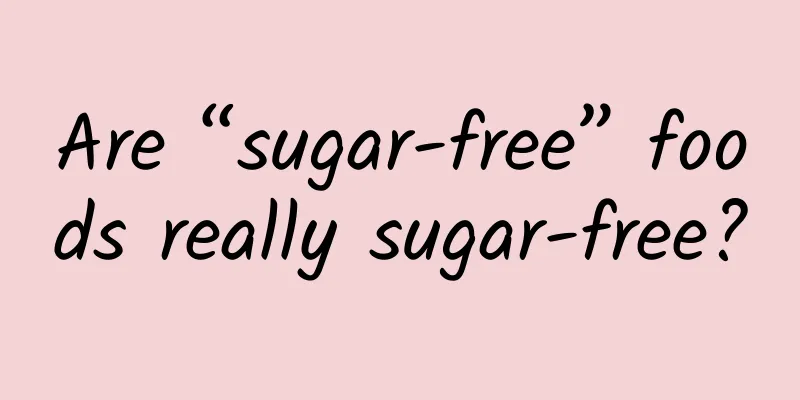Are “sugar-free” foods really sugar-free?

|
Are “sugar-free” foods really sugar-free? With the development of social economy and the gradual improvement of living conditions, health has received more and more attention from everyone. The harm of excessive sugar intake has been increasingly valued, and sugar-free foods have gradually become popular. Such as 0 sugar and 0 fat carbonated drinks, sugar-free and low-fat biscuits, 0 sugar and low-calorie oatmeal, sugar-free and low-calorie solid drinks, sugar-free snacks for diabetics... The dazzling array of sugar-free foods seem to come with a healthy halo and have become the favorites of many consumers. However, do "0 sugar" and "sugar-free" really contain no sugar? Can consumers eat them freely? To answer these questions, the Hangzhou Branch of the Food Safety Risk Early Warning Exchange Center and the joint monitoring station conducted random sampling and testing on the currently popular foods labeled "0 sugar" and "sugar-free". Let's take a look at the results~ 01 Experimental design The experimental samples selected in this experiment included 6 batches of common foods claiming to be sugar-free and ordinary foods on the market, namely: sandwich biscuits/0 sugar sandwich biscuits, sports drinks/sugar-free sports drinks, carbonated drinks/0 sugar carbonated drinks, inflated candies/sugar-free chewing gum, milk-containing jelly/0 sugar jelly, pure cakes/sugar-free cakes. 02 Results Analysis According to national standards, if a product claims to be "sugar-free" or "sugar-free", it must meet the requirement of "the sugar content in every 100 g of solid food or every 100 mL of liquid food shall not exceed 0.5 g". The "sugar" here refers to the sum of monosaccharides and disaccharides, that is, the sugar used in the nutrition label of pre-packaged food only includes mono/disaccharide components such as glucose, fructose, sucrose, and maltose. The claim of "sugar-free" does not mean that the food does not contain other types of carbohydrates. The experimental results show that the detection values of mono/disaccharide components such as glucose, fructose, sucrose, maltose, etc. in samples #1-2, #2-2, #3-2, #4-2, and #5-2 are all lower than 0.5 g/100 g (mL), which meets the relevant requirements for "sugar-free" and "0 sugar" claims. Although they meet the relevant requirements, are these foods really carbohydrate-free? The sucrose content of sample #1-2 was 0.27g/100g. The use of maltitol, erythritol, etc. instead of white sugar did reduce the "sugar" content in the product in a broad sense. However, a closer look at the food ingredients revealed that the first ingredient was wheat flour and the fifth ingredient clearly indicated that starch was also added. It can be inferred that the product may contain a large amount of starch. Starch will be converted into glucose after a series of reactions in the human body and can still generate high calories. Samples #4-2 and #5-2 also used sweeteners to completely replace white sugar and fructose syrup. However, in order to maintain a good taste and reduce costs, sweeteners are inevitably compounded with a variety of artificial sweeteners (such as sucralose, aspartame, acesulfame potassium, etc.). If consumed in large quantities for a long time, there may be certain safety risks. The ingredients of sample #6-2 use 6 sweet substances such as trehalose and maltose syrup instead of white sugar. Although the glycemic index is relatively low, the actual carbohydrate content and energy are not significantly reduced, and there is no significant difference from ordinary cakes. Therefore, the claim of "no sucrose" is only superficial and can easily mislead consumers. in conclusion The test results show that "0 sugar" and "sugar-free" do not really mean there is no sugar. The claims of "0 sugar" and "sugar-free" do not mean that the food does not contain other types of carbohydrates. For example, samples labeled "0 sugar" may contain starch, which will also increase blood sugar and produce energy. It has no practical significance for weight loss and blood sugar control in diabetic patients. 03 Consumption Tips Many consumers believe that "0 sugar" and "sugar-free" foods do not affect blood sugar and will not make them fat, but in fact, the content of high-productivity substances such as oil and starch in some "0 sugar" and "sugar-free" foods is not as low as imagined. Excessive consumption will also cause the accumulation of sugar and fat, which is harmful to health. When consumers choose "0 sugar" or "sugar-free" foods, it is recommended that they pay more attention to the product's ingredient list and nutritional information table: Added sugar alcohol sweeteners The metabolic process of sugar alcohols such as sorbitol, maltitol, xylitol, and erythritol basically does not require the participation of insulin, has a low glycemic index, and has little effect on blood sugar. However, these substances are metabolized slowly in the body, and long-term excessive intake can also cause adverse symptoms such as abdominal distension and diarrhea. It is not recommended for people with sugar alcohol intolerance, pregnant women, and children to consume them. Add artificial sweeteners Many "0 sugar" and "sugar-free" foods that taste sweet are mostly added with artificial sweeteners, such as aspartame, sucralose, acesulfame potassium, etc. Long-term and excessive consumption may pose potential risks to human health. Source: Zhejiang Food Safety Risk Early Warning Exchange Center Hangzhou Branch, Zhejiang Jiuan Testing Technology Co., Ltd. |
<<: Should you do an annual physical examination?
>>: Does snoring mean a good sleep? Wrong! It is a disease and needs to be treated!
Recommend
How to find the female sexual cycle
The female menstrual cycle is a very peculiar thi...
What indicators should be seen in the blood routine during pregnancy
How to determine the values of various indicato...
Gynecological liquid-based thin-layer cytology examination
In recent years, an intelligent cervical cytology...
Normal body fat for women
Women's physical health is very important, bu...
Slight bleeding on the third day of intercourse
Symptoms of discomfort in the human body must be ...
Can sodium bicarbonate cure gynecological diseases?
Due to the particularity of the female body struc...
Can women with high testosterone levels reduce their own testosterone levels?
Many people don't know what role testosterone...
How to treat women’s leucorrhea with odor?
Leucorrhea can basically be considered a friend o...
Is intermittent fasting, which has been repeatedly "deified", a "code for renewal" or a "health trap"?
Produced by: Science Popularization China Author:...
Skin will get better after sex
Your skin may get better after sex, which is due ...
How many of these rumors about milk do you believe?
Author: Han Lu, Associate Researcher, Chinese Cen...
How long does it take to recover from endocrine disorders?
After women enter puberty, the uterus and ovaries...
Don't panic if you are infected with HIV--Xiaoji is here to give you some advice
Don't panic if you are infected with HIV--Xia...
Symptoms of Qi and Yin Deficiency in Women
Qi and Yin deficiency is actually a symptom of a ...
Is the right uterine adnexal cyst serious?
Today's society is paying more and more atten...









